Qantas Report: Organisational Change and Development Strategies
VerifiedAdded on 2022/10/01
|17
|3809
|453
Report
AI Summary
This report provides a comprehensive analysis of organizational change and development within Qantas, an Australian airline. It begins with an introduction to Qantas and its operational context, followed by an examination of the issues the company faces, using a PESTLE analysis to assess the political, economic, social, technological, legal, and environmental factors impacting its performance. The report then delves into various change strategies, including Lewin's three-step model and the ADKAR model, evaluating their applicability to Qantas. Ultimately, it recommends Kotter's 8-step change model as the most suitable intervention, detailing each step's implementation within the Qantas context. The report also addresses potential issues, barriers, and ethical considerations associated with the recommended change interventions, concluding with a summary of the key findings and recommendations.

Student Name
INSTITUTIONAL AFFILIATION(S)
ORGANISATIONAL CHANGE
AND DEVELOPMENT
INSTITUTIONAL AFFILIATION(S)
ORGANISATIONAL CHANGE
AND DEVELOPMENT
Paraphrase This Document
Need a fresh take? Get an instant paraphrase of this document with our AI Paraphraser
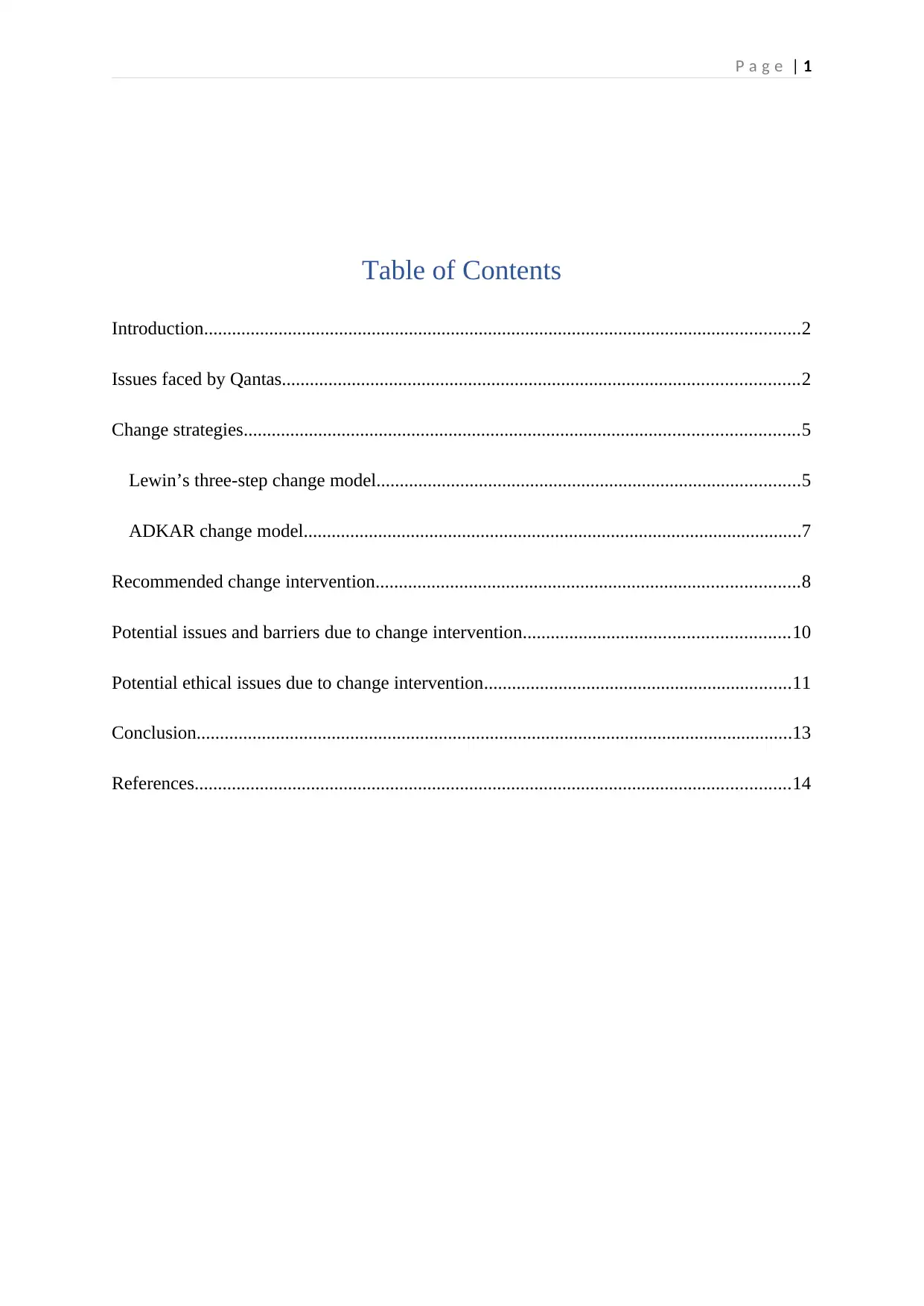
P a g e | 1
Table of Contents
Introduction................................................................................................................................2
Issues faced by Qantas...............................................................................................................2
Change strategies.......................................................................................................................5
Lewin’s three-step change model...........................................................................................5
ADKAR change model...........................................................................................................7
Recommended change intervention...........................................................................................8
Potential issues and barriers due to change intervention.........................................................10
Potential ethical issues due to change intervention..................................................................11
Conclusion................................................................................................................................13
References................................................................................................................................14
Table of Contents
Introduction................................................................................................................................2
Issues faced by Qantas...............................................................................................................2
Change strategies.......................................................................................................................5
Lewin’s three-step change model...........................................................................................5
ADKAR change model...........................................................................................................7
Recommended change intervention...........................................................................................8
Potential issues and barriers due to change intervention.........................................................10
Potential ethical issues due to change intervention..................................................................11
Conclusion................................................................................................................................13
References................................................................................................................................14
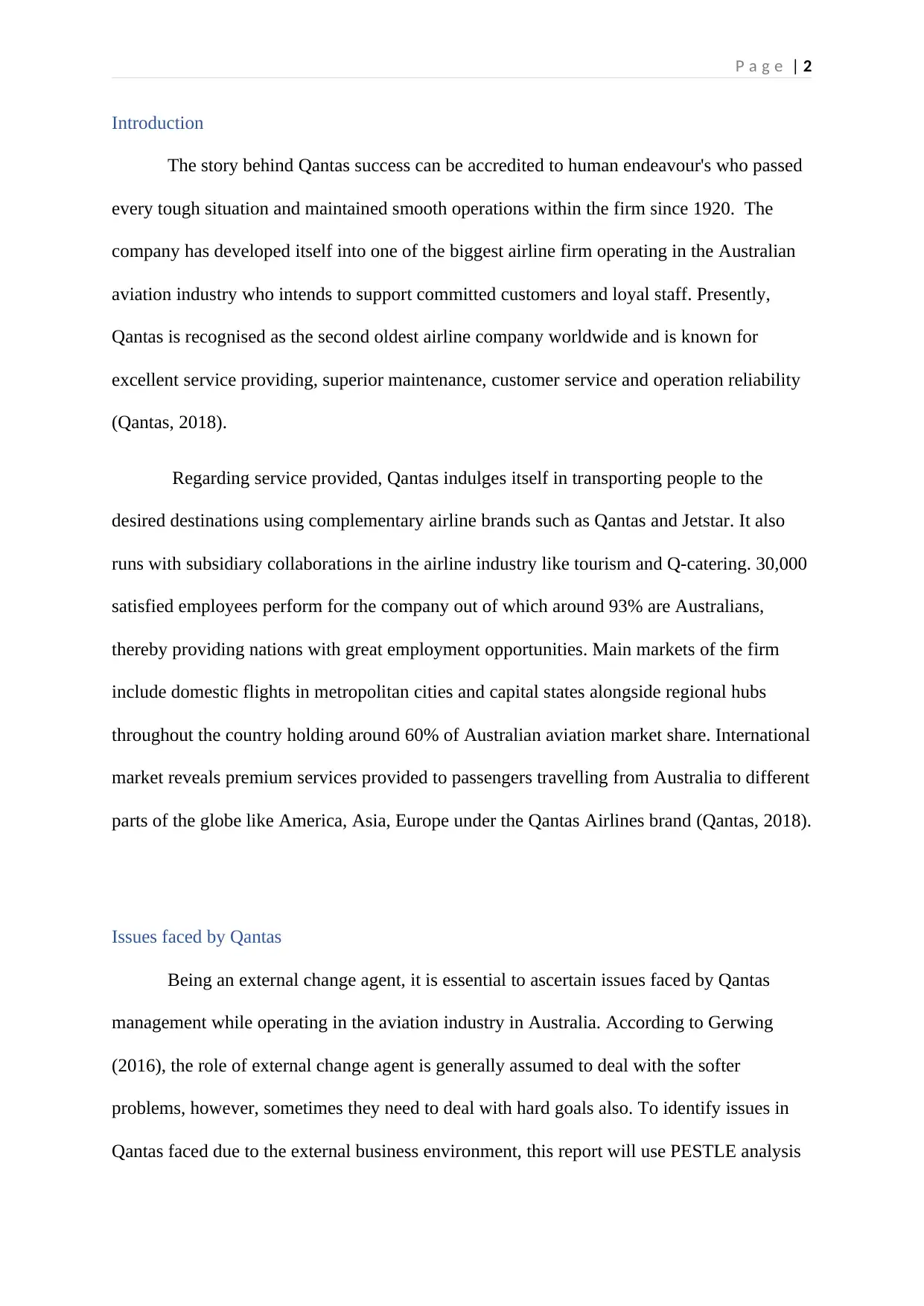
P a g e | 2
Introduction
The story behind Qantas success can be accredited to human endeavour's who passed
every tough situation and maintained smooth operations within the firm since 1920. The
company has developed itself into one of the biggest airline firm operating in the Australian
aviation industry who intends to support committed customers and loyal staff. Presently,
Qantas is recognised as the second oldest airline company worldwide and is known for
excellent service providing, superior maintenance, customer service and operation reliability
(Qantas, 2018).
Regarding service provided, Qantas indulges itself in transporting people to the
desired destinations using complementary airline brands such as Qantas and Jetstar. It also
runs with subsidiary collaborations in the airline industry like tourism and Q-catering. 30,000
satisfied employees perform for the company out of which around 93% are Australians,
thereby providing nations with great employment opportunities. Main markets of the firm
include domestic flights in metropolitan cities and capital states alongside regional hubs
throughout the country holding around 60% of Australian aviation market share. International
market reveals premium services provided to passengers travelling from Australia to different
parts of the globe like America, Asia, Europe under the Qantas Airlines brand (Qantas, 2018).
Issues faced by Qantas
Being an external change agent, it is essential to ascertain issues faced by Qantas
management while operating in the aviation industry in Australia. According to Gerwing
(2016), the role of external change agent is generally assumed to deal with the softer
problems, however, sometimes they need to deal with hard goals also. To identify issues in
Qantas faced due to the external business environment, this report will use PESTLE analysis
Introduction
The story behind Qantas success can be accredited to human endeavour's who passed
every tough situation and maintained smooth operations within the firm since 1920. The
company has developed itself into one of the biggest airline firm operating in the Australian
aviation industry who intends to support committed customers and loyal staff. Presently,
Qantas is recognised as the second oldest airline company worldwide and is known for
excellent service providing, superior maintenance, customer service and operation reliability
(Qantas, 2018).
Regarding service provided, Qantas indulges itself in transporting people to the
desired destinations using complementary airline brands such as Qantas and Jetstar. It also
runs with subsidiary collaborations in the airline industry like tourism and Q-catering. 30,000
satisfied employees perform for the company out of which around 93% are Australians,
thereby providing nations with great employment opportunities. Main markets of the firm
include domestic flights in metropolitan cities and capital states alongside regional hubs
throughout the country holding around 60% of Australian aviation market share. International
market reveals premium services provided to passengers travelling from Australia to different
parts of the globe like America, Asia, Europe under the Qantas Airlines brand (Qantas, 2018).
Issues faced by Qantas
Being an external change agent, it is essential to ascertain issues faced by Qantas
management while operating in the aviation industry in Australia. According to Gerwing
(2016), the role of external change agent is generally assumed to deal with the softer
problems, however, sometimes they need to deal with hard goals also. To identify issues in
Qantas faced due to the external business environment, this report will use PESTLE analysis
⊘ This is a preview!⊘
Do you want full access?
Subscribe today to unlock all pages.

Trusted by 1+ million students worldwide
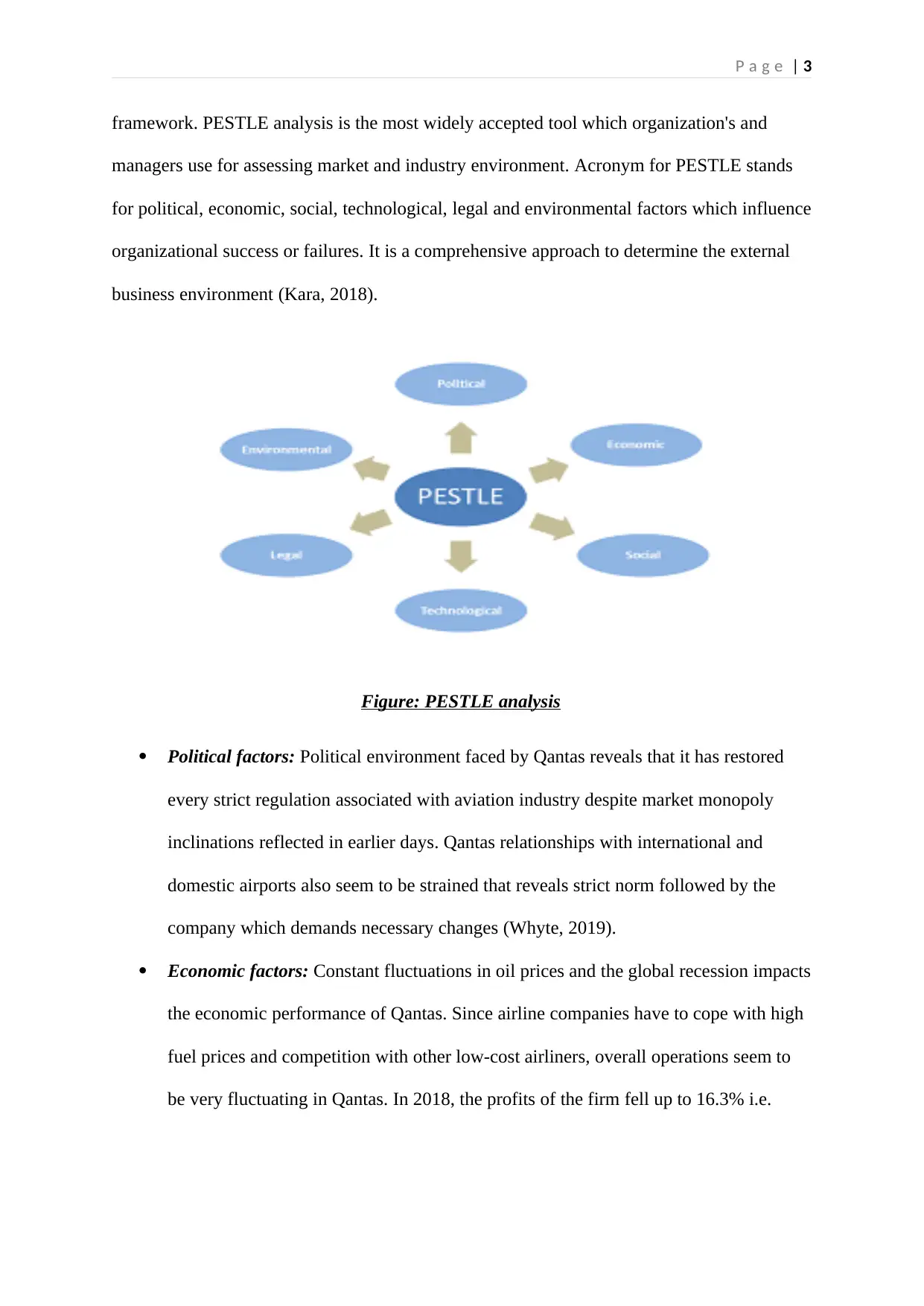
P a g e | 3
framework. PESTLE analysis is the most widely accepted tool which organization's and
managers use for assessing market and industry environment. Acronym for PESTLE stands
for political, economic, social, technological, legal and environmental factors which influence
organizational success or failures. It is a comprehensive approach to determine the external
business environment (Kara, 2018).
Figure: PESTLE analysis
Political factors: Political environment faced by Qantas reveals that it has restored
every strict regulation associated with aviation industry despite market monopoly
inclinations reflected in earlier days. Qantas relationships with international and
domestic airports also seem to be strained that reveals strict norm followed by the
company which demands necessary changes (Whyte, 2019).
Economic factors: Constant fluctuations in oil prices and the global recession impacts
the economic performance of Qantas. Since airline companies have to cope with high
fuel prices and competition with other low-cost airliners, overall operations seem to
be very fluctuating in Qantas. In 2018, the profits of the firm fell up to 16.3% i.e.
framework. PESTLE analysis is the most widely accepted tool which organization's and
managers use for assessing market and industry environment. Acronym for PESTLE stands
for political, economic, social, technological, legal and environmental factors which influence
organizational success or failures. It is a comprehensive approach to determine the external
business environment (Kara, 2018).
Figure: PESTLE analysis
Political factors: Political environment faced by Qantas reveals that it has restored
every strict regulation associated with aviation industry despite market monopoly
inclinations reflected in earlier days. Qantas relationships with international and
domestic airports also seem to be strained that reveals strict norm followed by the
company which demands necessary changes (Whyte, 2019).
Economic factors: Constant fluctuations in oil prices and the global recession impacts
the economic performance of Qantas. Since airline companies have to cope with high
fuel prices and competition with other low-cost airliners, overall operations seem to
be very fluctuating in Qantas. In 2018, the profits of the firm fell up to 16.3% i.e.
Paraphrase This Document
Need a fresh take? Get an instant paraphrase of this document with our AI Paraphraser

P a g e | 4
from $595 to $498 million due to ineffectiveness shown in its capacity management
in Australian airports (Whyte, 2019).
Social factors: The emergence of the mixed-consumer class have resulted in a
diversified change in service-related industries where consumers are seen to be more
demanding than ever. The wage and cost structure in Qantas reveal a significant
disadvantage for the firm as other competitors like Middle Easter carriers and Asian
Carriers flying in much lower rates which have shifted loyal consumers towards them
( Massola, Kenny, & Aston, 2014).
Technological factors: Intense competition in airline industry requires Qantas to
adopt the latest technology to survive completely in the local and international
market. Since Qantas is an iconic brand, it is expected that the firm uses every
resource in an optimum way by suing latest and innovative technologies to maintain
its stakeholders' interest in the company ( Massola, Kenny, & Aston, 2014).
Legal factors: Legal factors seems in favour of the company as it has maintained
every governmental and political expectation firmly. For instance, the company goes
fair with female and indigenous participation policies implemented by the Australian
government. The CEO of the firm, Alan Joyce reported that 130 female pilots operate
in 30 Qantas flights and around 40% of women representatives sharing company
board of directors (News.com.au, 2019).
Environmental factors: Qantas is subject to long-term and short-term climatic
changes due to physical transition made by flights. Such risks are the significant part
which the company has to deal with constantly and are managed with the help of
technology, corporate governance and market-based control (Qantas, 2018).
from $595 to $498 million due to ineffectiveness shown in its capacity management
in Australian airports (Whyte, 2019).
Social factors: The emergence of the mixed-consumer class have resulted in a
diversified change in service-related industries where consumers are seen to be more
demanding than ever. The wage and cost structure in Qantas reveal a significant
disadvantage for the firm as other competitors like Middle Easter carriers and Asian
Carriers flying in much lower rates which have shifted loyal consumers towards them
( Massola, Kenny, & Aston, 2014).
Technological factors: Intense competition in airline industry requires Qantas to
adopt the latest technology to survive completely in the local and international
market. Since Qantas is an iconic brand, it is expected that the firm uses every
resource in an optimum way by suing latest and innovative technologies to maintain
its stakeholders' interest in the company ( Massola, Kenny, & Aston, 2014).
Legal factors: Legal factors seems in favour of the company as it has maintained
every governmental and political expectation firmly. For instance, the company goes
fair with female and indigenous participation policies implemented by the Australian
government. The CEO of the firm, Alan Joyce reported that 130 female pilots operate
in 30 Qantas flights and around 40% of women representatives sharing company
board of directors (News.com.au, 2019).
Environmental factors: Qantas is subject to long-term and short-term climatic
changes due to physical transition made by flights. Such risks are the significant part
which the company has to deal with constantly and are managed with the help of
technology, corporate governance and market-based control (Qantas, 2018).
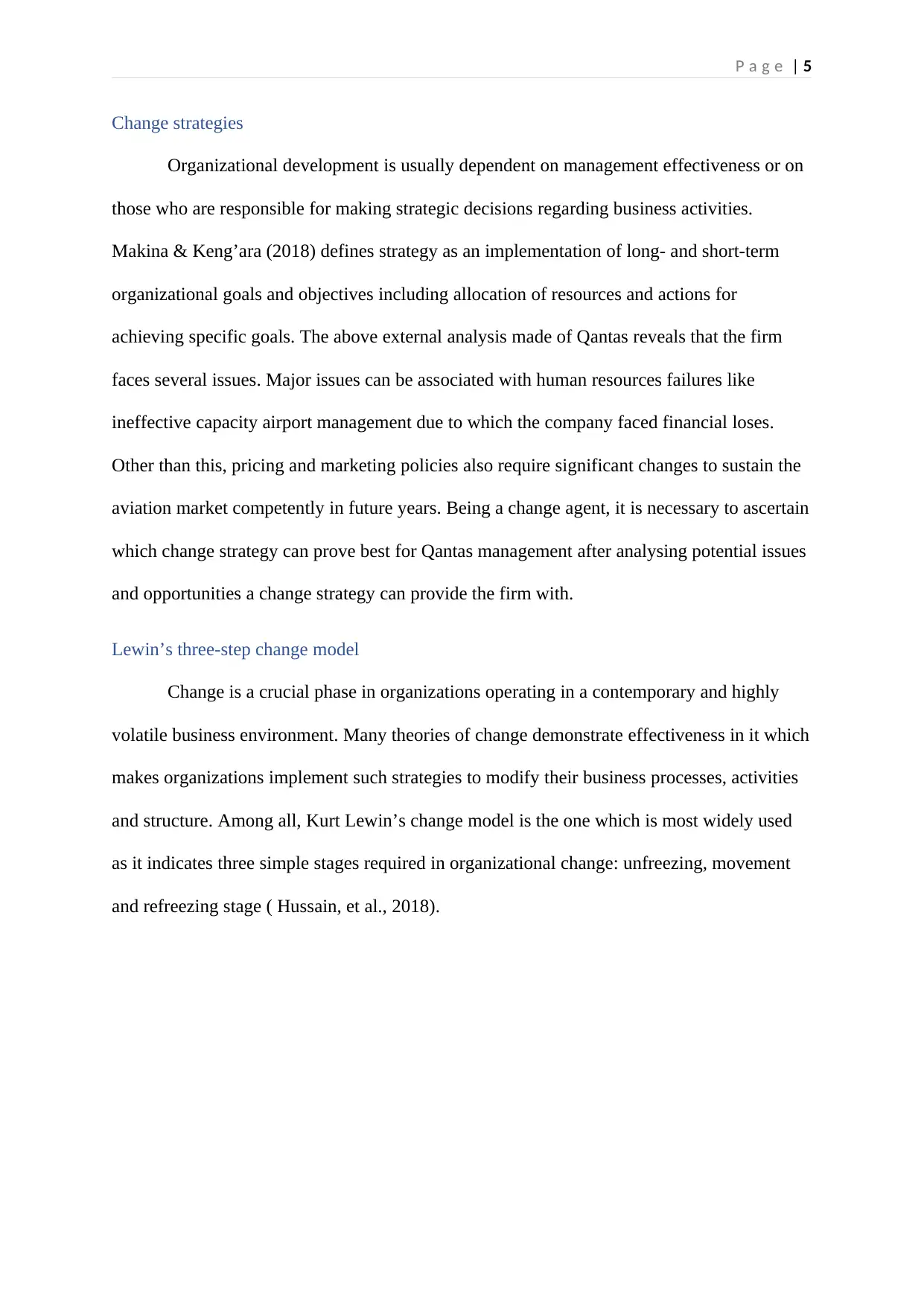
P a g e | 5
Change strategies
Organizational development is usually dependent on management effectiveness or on
those who are responsible for making strategic decisions regarding business activities.
Makina & Keng’ara (2018) defines strategy as an implementation of long- and short-term
organizational goals and objectives including allocation of resources and actions for
achieving specific goals. The above external analysis made of Qantas reveals that the firm
faces several issues. Major issues can be associated with human resources failures like
ineffective capacity airport management due to which the company faced financial loses.
Other than this, pricing and marketing policies also require significant changes to sustain the
aviation market competently in future years. Being a change agent, it is necessary to ascertain
which change strategy can prove best for Qantas management after analysing potential issues
and opportunities a change strategy can provide the firm with.
Lewin’s three-step change model
Change is a crucial phase in organizations operating in a contemporary and highly
volatile business environment. Many theories of change demonstrate effectiveness in it which
makes organizations implement such strategies to modify their business processes, activities
and structure. Among all, Kurt Lewin’s change model is the one which is most widely used
as it indicates three simple stages required in organizational change: unfreezing, movement
and refreezing stage ( Hussain, et al., 2018).
Change strategies
Organizational development is usually dependent on management effectiveness or on
those who are responsible for making strategic decisions regarding business activities.
Makina & Keng’ara (2018) defines strategy as an implementation of long- and short-term
organizational goals and objectives including allocation of resources and actions for
achieving specific goals. The above external analysis made of Qantas reveals that the firm
faces several issues. Major issues can be associated with human resources failures like
ineffective capacity airport management due to which the company faced financial loses.
Other than this, pricing and marketing policies also require significant changes to sustain the
aviation market competently in future years. Being a change agent, it is necessary to ascertain
which change strategy can prove best for Qantas management after analysing potential issues
and opportunities a change strategy can provide the firm with.
Lewin’s three-step change model
Change is a crucial phase in organizations operating in a contemporary and highly
volatile business environment. Many theories of change demonstrate effectiveness in it which
makes organizations implement such strategies to modify their business processes, activities
and structure. Among all, Kurt Lewin’s change model is the one which is most widely used
as it indicates three simple stages required in organizational change: unfreezing, movement
and refreezing stage ( Hussain, et al., 2018).
⊘ This is a preview!⊘
Do you want full access?
Subscribe today to unlock all pages.

Trusted by 1+ million students worldwide
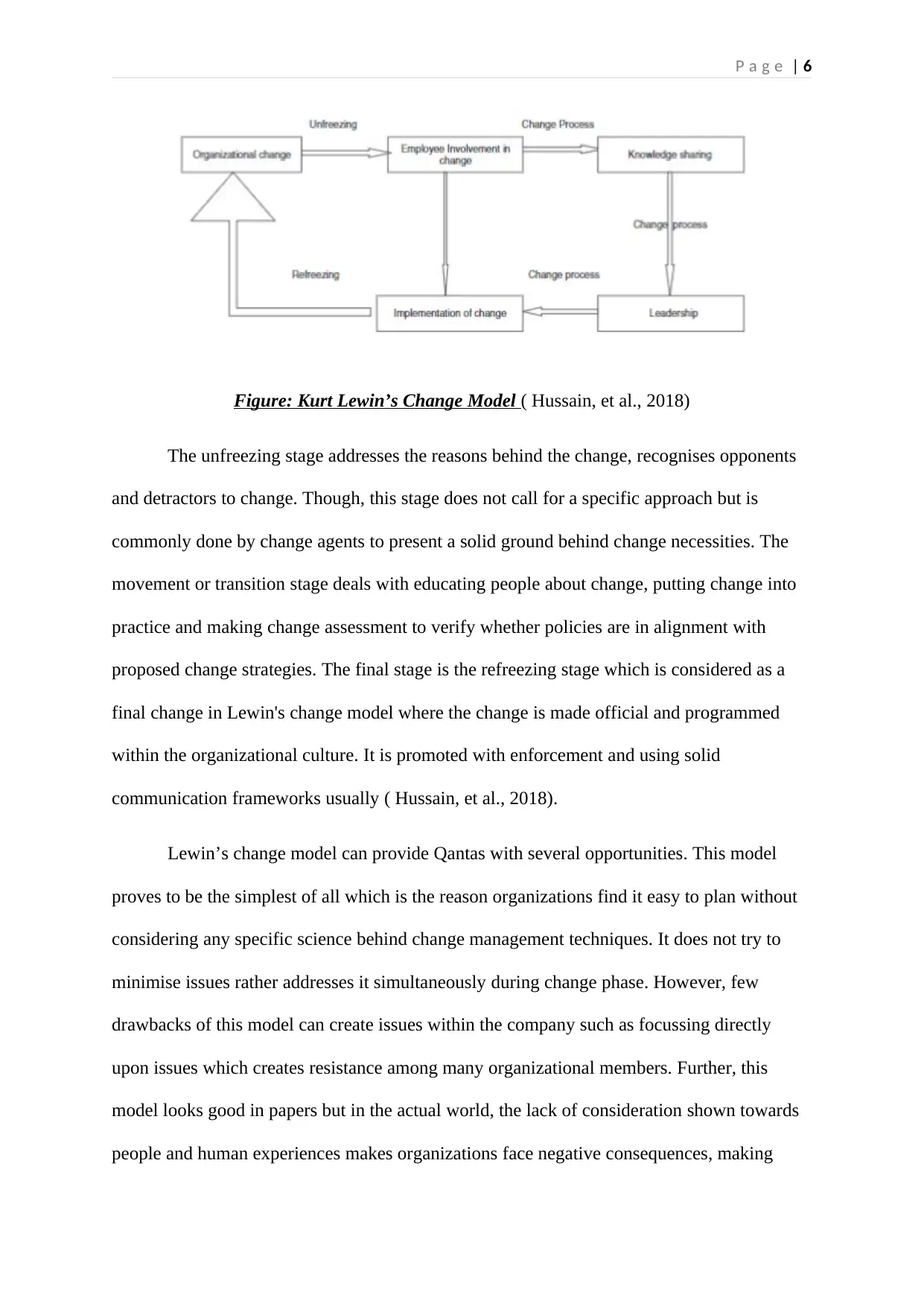
P a g e | 6
Figure: Kurt Lewin’s Change Model ( Hussain, et al., 2018)
The unfreezing stage addresses the reasons behind the change, recognises opponents
and detractors to change. Though, this stage does not call for a specific approach but is
commonly done by change agents to present a solid ground behind change necessities. The
movement or transition stage deals with educating people about change, putting change into
practice and making change assessment to verify whether policies are in alignment with
proposed change strategies. The final stage is the refreezing stage which is considered as a
final change in Lewin's change model where the change is made official and programmed
within the organizational culture. It is promoted with enforcement and using solid
communication frameworks usually ( Hussain, et al., 2018).
Lewin’s change model can provide Qantas with several opportunities. This model
proves to be the simplest of all which is the reason organizations find it easy to plan without
considering any specific science behind change management techniques. It does not try to
minimise issues rather addresses it simultaneously during change phase. However, few
drawbacks of this model can create issues within the company such as focussing directly
upon issues which creates resistance among many organizational members. Further, this
model looks good in papers but in the actual world, the lack of consideration shown towards
people and human experiences makes organizations face negative consequences, making
Figure: Kurt Lewin’s Change Model ( Hussain, et al., 2018)
The unfreezing stage addresses the reasons behind the change, recognises opponents
and detractors to change. Though, this stage does not call for a specific approach but is
commonly done by change agents to present a solid ground behind change necessities. The
movement or transition stage deals with educating people about change, putting change into
practice and making change assessment to verify whether policies are in alignment with
proposed change strategies. The final stage is the refreezing stage which is considered as a
final change in Lewin's change model where the change is made official and programmed
within the organizational culture. It is promoted with enforcement and using solid
communication frameworks usually ( Hussain, et al., 2018).
Lewin’s change model can provide Qantas with several opportunities. This model
proves to be the simplest of all which is the reason organizations find it easy to plan without
considering any specific science behind change management techniques. It does not try to
minimise issues rather addresses it simultaneously during change phase. However, few
drawbacks of this model can create issues within the company such as focussing directly
upon issues which creates resistance among many organizational members. Further, this
model looks good in papers but in the actual world, the lack of consideration shown towards
people and human experiences makes organizations face negative consequences, making
Paraphrase This Document
Need a fresh take? Get an instant paraphrase of this document with our AI Paraphraser

P a g e | 7
employees less enthusiastic about the new change in their workplace (Cummings, Bridgman,
& Brown, 2016).
ADKAR change model
Figure: ADKAR Model ( J & Mary, 2017)
ADKAR model is another change model which helps enterprises through change
phases as every action taken in this model usually fits into common activities related to
change organizations. Accordingly, the first step of this model is creating awareness in which
change agents or internal managers proposes objectives behind changes after considering
post-change effects and targets that can be achieved at different change levels. Desire is the
next step which reveals the longing to get connected and take interest in the organizational
change occurring due to resistance management and sponsorship programs. Knowledge
collaborates and instils various dimensions of appreciation and information associated with
change. Ability recognises capabilities in change agents and whether the change is executed
at every necessary level (Blomqvist, 2017).
Reinforcement is the final step which is supported by motivational and influential
factors to avoid any hurdles interrogating the change path ( J & Mary, 2017). The successful
implementation of the ADKAR model can result in recognising opportunities like fine-tuning
with Qantas management and strategies which requires to be adopted. Moreover, this model
is cumulative and sequential making it a more practical approach. However, this model also
has few issues like a failure in distinguishing between functions and the role of leadership
employees less enthusiastic about the new change in their workplace (Cummings, Bridgman,
& Brown, 2016).
ADKAR change model
Figure: ADKAR Model ( J & Mary, 2017)
ADKAR model is another change model which helps enterprises through change
phases as every action taken in this model usually fits into common activities related to
change organizations. Accordingly, the first step of this model is creating awareness in which
change agents or internal managers proposes objectives behind changes after considering
post-change effects and targets that can be achieved at different change levels. Desire is the
next step which reveals the longing to get connected and take interest in the organizational
change occurring due to resistance management and sponsorship programs. Knowledge
collaborates and instils various dimensions of appreciation and information associated with
change. Ability recognises capabilities in change agents and whether the change is executed
at every necessary level (Blomqvist, 2017).
Reinforcement is the final step which is supported by motivational and influential
factors to avoid any hurdles interrogating the change path ( J & Mary, 2017). The successful
implementation of the ADKAR model can result in recognising opportunities like fine-tuning
with Qantas management and strategies which requires to be adopted. Moreover, this model
is cumulative and sequential making it a more practical approach. However, this model also
has few issues like a failure in distinguishing between functions and the role of leadership
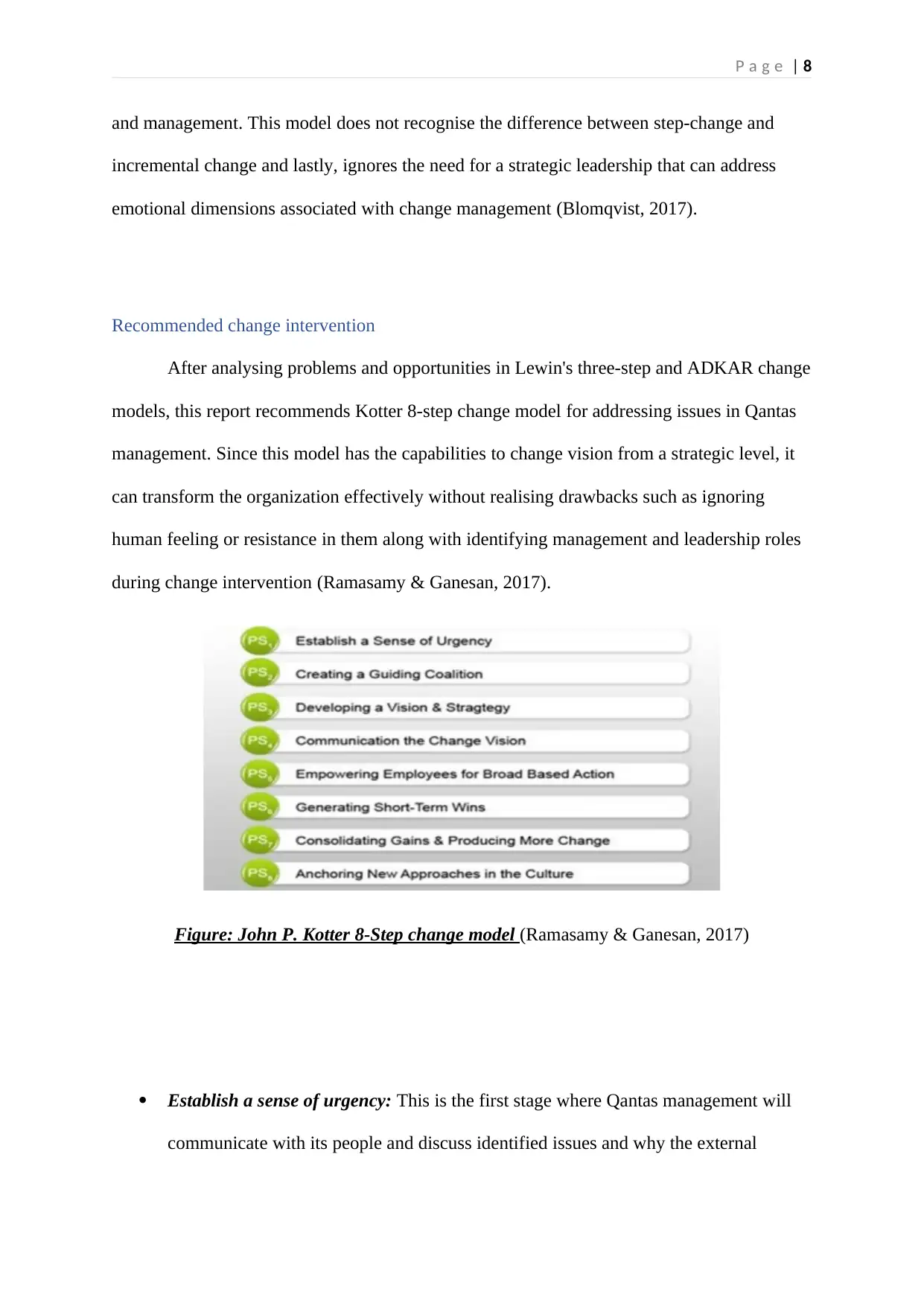
P a g e | 8
and management. This model does not recognise the difference between step-change and
incremental change and lastly, ignores the need for a strategic leadership that can address
emotional dimensions associated with change management (Blomqvist, 2017).
Recommended change intervention
After analysing problems and opportunities in Lewin's three-step and ADKAR change
models, this report recommends Kotter 8-step change model for addressing issues in Qantas
management. Since this model has the capabilities to change vision from a strategic level, it
can transform the organization effectively without realising drawbacks such as ignoring
human feeling or resistance in them along with identifying management and leadership roles
during change intervention (Ramasamy & Ganesan, 2017).
Figure: John P. Kotter 8-Step change model (Ramasamy & Ganesan, 2017)
Establish a sense of urgency: This is the first stage where Qantas management will
communicate with its people and discuss identified issues and why the external
and management. This model does not recognise the difference between step-change and
incremental change and lastly, ignores the need for a strategic leadership that can address
emotional dimensions associated with change management (Blomqvist, 2017).
Recommended change intervention
After analysing problems and opportunities in Lewin's three-step and ADKAR change
models, this report recommends Kotter 8-step change model for addressing issues in Qantas
management. Since this model has the capabilities to change vision from a strategic level, it
can transform the organization effectively without realising drawbacks such as ignoring
human feeling or resistance in them along with identifying management and leadership roles
during change intervention (Ramasamy & Ganesan, 2017).
Figure: John P. Kotter 8-Step change model (Ramasamy & Ganesan, 2017)
Establish a sense of urgency: This is the first stage where Qantas management will
communicate with its people and discuss identified issues and why the external
⊘ This is a preview!⊘
Do you want full access?
Subscribe today to unlock all pages.

Trusted by 1+ million students worldwide
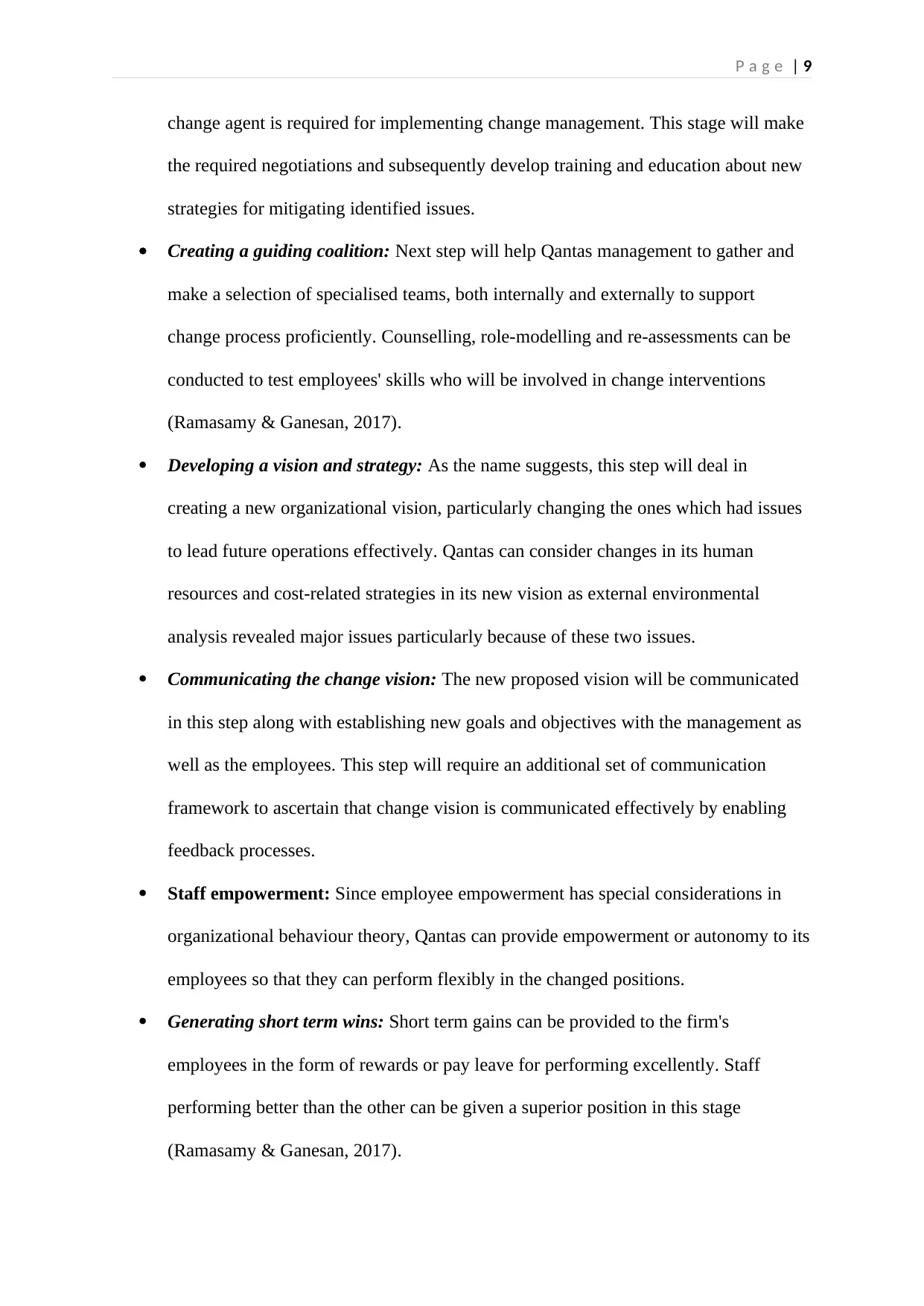
P a g e | 9
change agent is required for implementing change management. This stage will make
the required negotiations and subsequently develop training and education about new
strategies for mitigating identified issues.
Creating a guiding coalition: Next step will help Qantas management to gather and
make a selection of specialised teams, both internally and externally to support
change process proficiently. Counselling, role-modelling and re-assessments can be
conducted to test employees' skills who will be involved in change interventions
(Ramasamy & Ganesan, 2017).
Developing a vision and strategy: As the name suggests, this step will deal in
creating a new organizational vision, particularly changing the ones which had issues
to lead future operations effectively. Qantas can consider changes in its human
resources and cost-related strategies in its new vision as external environmental
analysis revealed major issues particularly because of these two issues.
Communicating the change vision: The new proposed vision will be communicated
in this step along with establishing new goals and objectives with the management as
well as the employees. This step will require an additional set of communication
framework to ascertain that change vision is communicated effectively by enabling
feedback processes.
Staff empowerment: Since employee empowerment has special considerations in
organizational behaviour theory, Qantas can provide empowerment or autonomy to its
employees so that they can perform flexibly in the changed positions.
Generating short term wins: Short term gains can be provided to the firm's
employees in the form of rewards or pay leave for performing excellently. Staff
performing better than the other can be given a superior position in this stage
(Ramasamy & Ganesan, 2017).
change agent is required for implementing change management. This stage will make
the required negotiations and subsequently develop training and education about new
strategies for mitigating identified issues.
Creating a guiding coalition: Next step will help Qantas management to gather and
make a selection of specialised teams, both internally and externally to support
change process proficiently. Counselling, role-modelling and re-assessments can be
conducted to test employees' skills who will be involved in change interventions
(Ramasamy & Ganesan, 2017).
Developing a vision and strategy: As the name suggests, this step will deal in
creating a new organizational vision, particularly changing the ones which had issues
to lead future operations effectively. Qantas can consider changes in its human
resources and cost-related strategies in its new vision as external environmental
analysis revealed major issues particularly because of these two issues.
Communicating the change vision: The new proposed vision will be communicated
in this step along with establishing new goals and objectives with the management as
well as the employees. This step will require an additional set of communication
framework to ascertain that change vision is communicated effectively by enabling
feedback processes.
Staff empowerment: Since employee empowerment has special considerations in
organizational behaviour theory, Qantas can provide empowerment or autonomy to its
employees so that they can perform flexibly in the changed positions.
Generating short term wins: Short term gains can be provided to the firm's
employees in the form of rewards or pay leave for performing excellently. Staff
performing better than the other can be given a superior position in this stage
(Ramasamy & Ganesan, 2017).
Paraphrase This Document
Need a fresh take? Get an instant paraphrase of this document with our AI Paraphraser
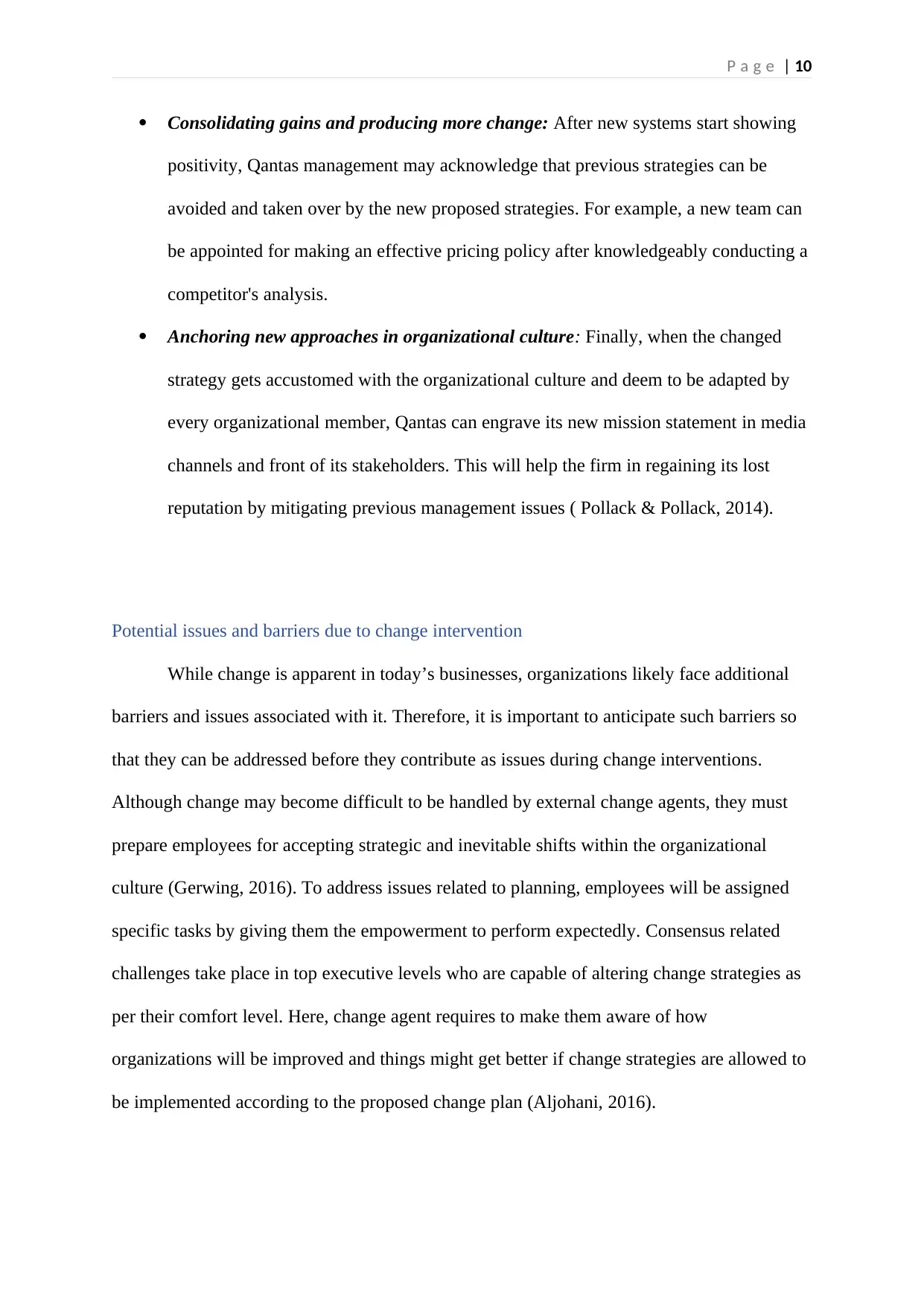
P a g e | 10
Consolidating gains and producing more change: After new systems start showing
positivity, Qantas management may acknowledge that previous strategies can be
avoided and taken over by the new proposed strategies. For example, a new team can
be appointed for making an effective pricing policy after knowledgeably conducting a
competitor's analysis.
Anchoring new approaches in organizational culture: Finally, when the changed
strategy gets accustomed with the organizational culture and deem to be adapted by
every organizational member, Qantas can engrave its new mission statement in media
channels and front of its stakeholders. This will help the firm in regaining its lost
reputation by mitigating previous management issues ( Pollack & Pollack, 2014).
Potential issues and barriers due to change intervention
While change is apparent in today’s businesses, organizations likely face additional
barriers and issues associated with it. Therefore, it is important to anticipate such barriers so
that they can be addressed before they contribute as issues during change interventions.
Although change may become difficult to be handled by external change agents, they must
prepare employees for accepting strategic and inevitable shifts within the organizational
culture (Gerwing, 2016). To address issues related to planning, employees will be assigned
specific tasks by giving them the empowerment to perform expectedly. Consensus related
challenges take place in top executive levels who are capable of altering change strategies as
per their comfort level. Here, change agent requires to make them aware of how
organizations will be improved and things might get better if change strategies are allowed to
be implemented according to the proposed change plan (Aljohani, 2016).
Consolidating gains and producing more change: After new systems start showing
positivity, Qantas management may acknowledge that previous strategies can be
avoided and taken over by the new proposed strategies. For example, a new team can
be appointed for making an effective pricing policy after knowledgeably conducting a
competitor's analysis.
Anchoring new approaches in organizational culture: Finally, when the changed
strategy gets accustomed with the organizational culture and deem to be adapted by
every organizational member, Qantas can engrave its new mission statement in media
channels and front of its stakeholders. This will help the firm in regaining its lost
reputation by mitigating previous management issues ( Pollack & Pollack, 2014).
Potential issues and barriers due to change intervention
While change is apparent in today’s businesses, organizations likely face additional
barriers and issues associated with it. Therefore, it is important to anticipate such barriers so
that they can be addressed before they contribute as issues during change interventions.
Although change may become difficult to be handled by external change agents, they must
prepare employees for accepting strategic and inevitable shifts within the organizational
culture (Gerwing, 2016). To address issues related to planning, employees will be assigned
specific tasks by giving them the empowerment to perform expectedly. Consensus related
challenges take place in top executive levels who are capable of altering change strategies as
per their comfort level. Here, change agent requires to make them aware of how
organizations will be improved and things might get better if change strategies are allowed to
be implemented according to the proposed change plan (Aljohani, 2016).
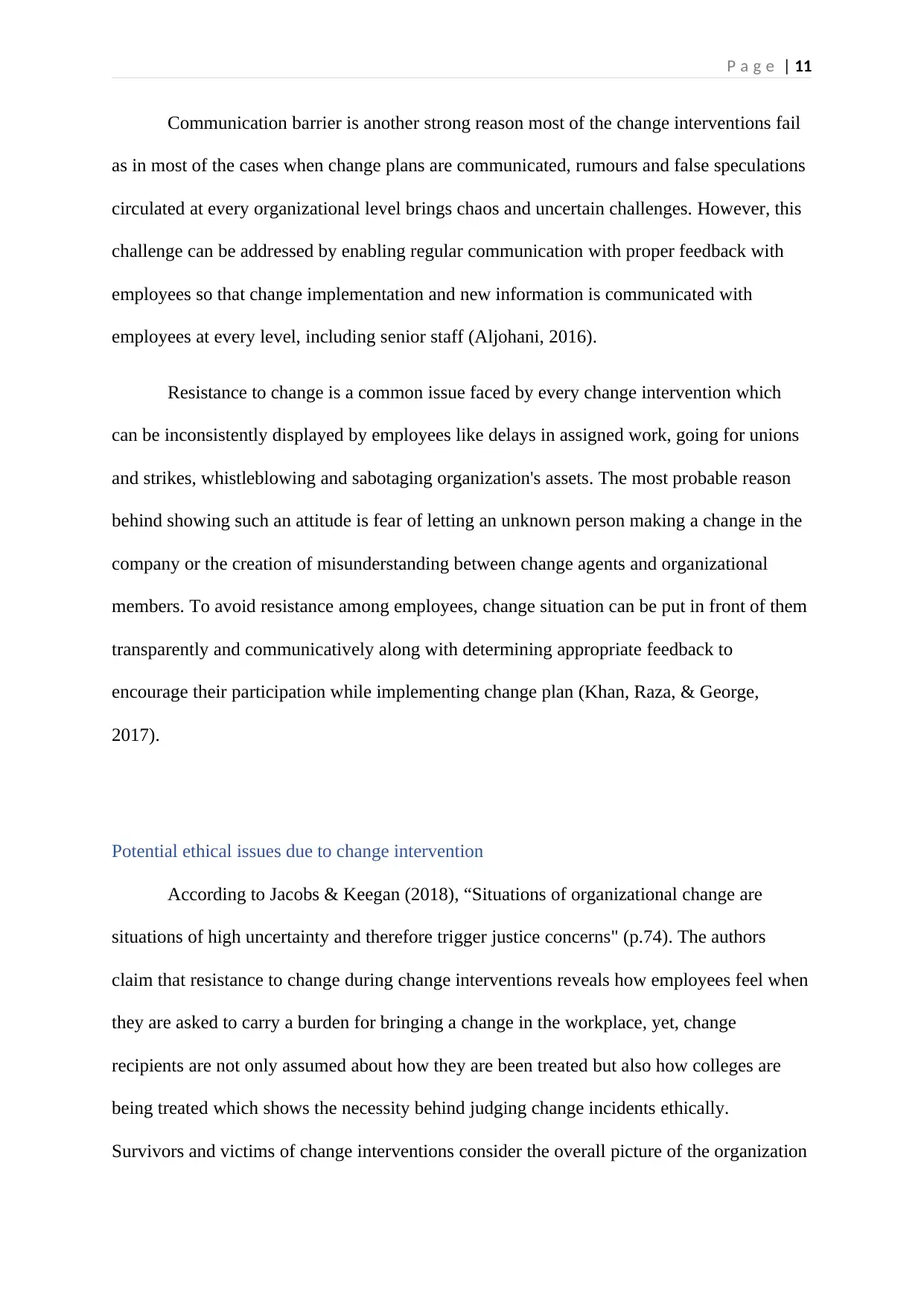
P a g e | 11
Communication barrier is another strong reason most of the change interventions fail
as in most of the cases when change plans are communicated, rumours and false speculations
circulated at every organizational level brings chaos and uncertain challenges. However, this
challenge can be addressed by enabling regular communication with proper feedback with
employees so that change implementation and new information is communicated with
employees at every level, including senior staff (Aljohani, 2016).
Resistance to change is a common issue faced by every change intervention which
can be inconsistently displayed by employees like delays in assigned work, going for unions
and strikes, whistleblowing and sabotaging organization's assets. The most probable reason
behind showing such an attitude is fear of letting an unknown person making a change in the
company or the creation of misunderstanding between change agents and organizational
members. To avoid resistance among employees, change situation can be put in front of them
transparently and communicatively along with determining appropriate feedback to
encourage their participation while implementing change plan (Khan, Raza, & George,
2017).
Potential ethical issues due to change intervention
According to Jacobs & Keegan (2018), “Situations of organizational change are
situations of high uncertainty and therefore trigger justice concerns" (p.74). The authors
claim that resistance to change during change interventions reveals how employees feel when
they are asked to carry a burden for bringing a change in the workplace, yet, change
recipients are not only assumed about how they are been treated but also how colleges are
being treated which shows the necessity behind judging change incidents ethically.
Survivors and victims of change interventions consider the overall picture of the organization
Communication barrier is another strong reason most of the change interventions fail
as in most of the cases when change plans are communicated, rumours and false speculations
circulated at every organizational level brings chaos and uncertain challenges. However, this
challenge can be addressed by enabling regular communication with proper feedback with
employees so that change implementation and new information is communicated with
employees at every level, including senior staff (Aljohani, 2016).
Resistance to change is a common issue faced by every change intervention which
can be inconsistently displayed by employees like delays in assigned work, going for unions
and strikes, whistleblowing and sabotaging organization's assets. The most probable reason
behind showing such an attitude is fear of letting an unknown person making a change in the
company or the creation of misunderstanding between change agents and organizational
members. To avoid resistance among employees, change situation can be put in front of them
transparently and communicatively along with determining appropriate feedback to
encourage their participation while implementing change plan (Khan, Raza, & George,
2017).
Potential ethical issues due to change intervention
According to Jacobs & Keegan (2018), “Situations of organizational change are
situations of high uncertainty and therefore trigger justice concerns" (p.74). The authors
claim that resistance to change during change interventions reveals how employees feel when
they are asked to carry a burden for bringing a change in the workplace, yet, change
recipients are not only assumed about how they are been treated but also how colleges are
being treated which shows the necessity behind judging change incidents ethically.
Survivors and victims of change interventions consider the overall picture of the organization
⊘ This is a preview!⊘
Do you want full access?
Subscribe today to unlock all pages.

Trusted by 1+ million students worldwide
1 out of 17
Related Documents
Your All-in-One AI-Powered Toolkit for Academic Success.
+13062052269
info@desklib.com
Available 24*7 on WhatsApp / Email
![[object Object]](/_next/static/media/star-bottom.7253800d.svg)
Unlock your academic potential
Copyright © 2020–2025 A2Z Services. All Rights Reserved. Developed and managed by ZUCOL.





